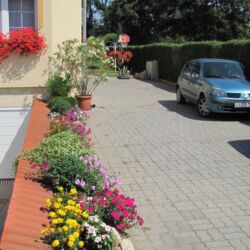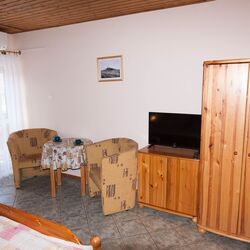The sweetest form of love: a perfectly baked pastry
Have you ever tasted a honey gingerbread cookie that melts in your mouth? MézÉdes Műhely’s signature product has gained nationwide recognition thanks to its perfect texture and secret spice blend. Come and discover the delightful treats crafted in the fragrant kitchen of MézÉdes Műhely!
When two passions meet
Adorjánné Baráth Mónika and her daughter, Adorján Bori, once ran a family restaurant. Over time, Bori found herself more and more drawn to dessert-making. Inspired by guests’ feedback and her own love of baking, she completed pastry school, combining professional expertise with artisan methods.
Mónika, however, mastered homestyle baking at home, delighting her family daily with sweet “tészták” — as pastries are affectionately called in Zala.
Their first large-scale order came from a hotel in Hévíz for edible Christmas gifts. Instead of gingerbread, they revived an old family recipe: honey gingerbread cookies.
During the pandemic, as the restaurant industry paused, the growing success of their gingerbread led them to a new path. The family closed their restaurant and founded MézÉdes Műhely — not as a traditional pastry shop, but as a creative workshop where they could bake without compromises, at their own rhythm.
Modern cakes & traditional pastries
Today, everyone has their own specialty at MézÉdes Műhely. Bori is the master of modern cakes, tarts, macarons, and custom orders, while her mother Mónika focuses on traditional pastries — layered honey cakes, cream slices, flódni, and zserbó.
Many recipes are cherished family heirlooms, passed down from great-grandmothers, aunts, and grandmothers, now adapted to their own taste. Each dessert includes a personal twist — making it homely, unique, and unmistakably MézÉdes.
Honey gingerbread cookies that spark sweet memories
MézÉdes Műhely’s honey gingerbread cookies are a nostalgic journey, evoking the warmth of grandma’s kitchen and the comforting aroma of Christmas spices. Coated in a white sugar glaze, these cookies delight not just with their appearance, but with their taste and texture. Each bite melts gently in your mouth.
The secret lies in their custom-made spice blend of eight aromatic spices. The honey, sourced from a local beekeeper in Gyenesdiás, ensures an authentic, rich flavor. Mónika and Bori enjoy experimenting with new flavors. A recent innovation is their wholegrain version, made with spelt and wheat flour.
One of their summer favorites is lavender-flavored gingerbread, made with lavender grown, harvested, and dried from their own garden.
Not a pastry shop — A family atelier
MézÉdes Műhely is not a conventional pastry shop. Their sweets are made to order and sold at the Hévíz Farmers’ Market. Personal interactions — whether through market tastings or scheduled visits — are an essential part of their philosophy.
Product highlights
Honey gingerbread cookies
MézÉdes Műhely’s flagship product, the honey gingerbread cookie, comes in a variety of flavors. The dough is dense yet soft, melting instantly in the mouth — no need to wait days for it to soften.
The perfect texture is achieved using a traditional recipe: flour, sugar, margarine, eggs, sour cream, baking soda, and a secret spice blend of eight ingredients.
Each cookie is hand-rolled, placed individually on baking trays, and, after baking, dipped by hand into sugar glaze. They are then carefully lined up to dry — every piece crafted with care. Flavors include both classic and unique variations: plain, plum-rum, cranberry, candied orange, ginger (without glaze), cocoa with chocolate chips, and seasonal lavender. The lavender used in summer varieties blooms every June in the workshop’s garden.
Where to buy:
- Hévíz Farmers’ Market
- 8380 Hévíz, Egregyi Vineyard 38
- Google Maps
More information & Contact:
- Phone: +36 30 658 6739
Imagine a vast body of water — over 1,000 meters deep and more than 400 times the size of Lake Balaton — once rippling across this land. The story of the Pannonian Lake is not just a fascinating chapter of geological history, but a legacy that continues to shape the region: it left behind mineral resources, fertile soils, and even inspired legends. Discover how an ancient lake transformed Transdanubia — and why its impact is still felt today. An Inland Sea for Millions of Years At its greatest extent, the Pannonian Lake covered an enormous area, far surpassing the size of today’s Balaton. For millions of years (approximately 12 to 8.5 million years ago), it dominated the region. As surrounding mountain ranges gradually rose, the lake became cut off from the world’s oceans. Its water slowly turned fresh, and its basin began to fill with sediments. Because of its isolation, the lake developed a unique ecosystem with many endemic species. The Lake Didn’t Appear Overnight The Pannonian Lake didn’t simply “appear” in the Carpathian Basin. Its formation was the result of millions of years of tectonic activity and shifting climate. It emerged as an independent, enclosed body of water — no longer connected to the open seas. Deep Waters, Varied Shores In some areas, the lake reached depths of over 1,000 meters. Elsewhere, shallower zones supported lagoons, river deltas, and small, isolated lakes. During high water periods, rocky shorelines formed along the mountain fringes — traces of which can still be found today in the Keszthely Hills and the Mecsek Mountains. The Lake’s Retreat — and Sediment Legacy Despite its size, the lake was eventually filled in by immense volumes of sediment, carried mainly by rivers flowing from the Alps and the Carpathians. Over the course of 6.5 million years, it gradually disappeared from the landscape. What did it leave behind? Its sediments — composed mostly of sand, clay, and fine silt — became the so-called “Pannonian formations,” which today hold key mineral resources (such as petroleum) and aquifers. These formations define much of the surface geology of Transdanubia, including the Zala Hills. Fertile soils later formed on the laminated silty and clay-rich deposits of the Somló Formation. Even the legendary “Tihany goat’s hoof” fossils — actually worn shell fragments of the Congeria ungulacaprae mollusk — can still be found embedded in these ancient layers. The Final Lakes and a Gradual Goodbye Because most of the sediment entered from the northwest, north, and northeast, the lake slowly retreated toward the south and southeast — as if it were “withdrawing” from what is now Hungary. Small remnant lakes persisted for much longer in areas of present-day Slavonia (Croatia) and northern Serbia, but due to their different scale, character, and fauna, they are not considered true successors of the ancient Pannonian Lake.

















